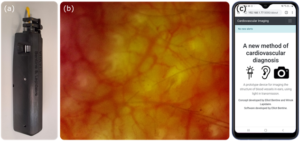Portable imaging device for early detection of cardiovascular disease

Cardiovascular diseases (CVDs) are heart and blood vessels conditions, including strokes and heart attacks. CVDs are the leading cause of deaths globally and a major contributor to disability. It is estimated that CVDs caused over 17 million deaths in 2016.
CVDs are strongly linked to physiological and structural changes of the microvasculature, such as vessel size and branching. These alterations often precede major cardiovascular events and can be used as early diagnostic markers for CVDs. Early detection of these changes may lead to improved patient outcomes.
Detecting CVDs early
Commonly, retinal imaging or MRI are used to detect and diagnose CVDs. MRIs provide detailed imaging of the larger vessels and retinal imaging allows direct visualisation of the microvasculature in the eye. Although effective, these imaging methods can be expensive and time-consuming. Furthermore, they are unsuitable for some patients; for example, they cannot be brought to the bedside.
By exploiting techniques from microscopy, optics and laser technology, Oxford scientists have developed VITA (Vasculature Imaging Tool for the Auricle), a portable device for imaging the ear vasculature.
This device functions by transmitting light through the ear, which allows a wide range of complementary imaging techniques to be used. These different techniques offer sensitivity to a range of disease biomarkers.
Imaging the ear also gives a range of practical advantages. The ear can withstand much brighter light than the eye which increases the image quality. Imaging the ear, rather than the retina, means that children or individuals that struggle to keep their eyes open can be easily examined.
The small design and smartphone compatibility allows the device to be portable and used in various settings.
about this technology

